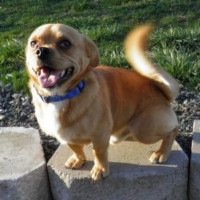Appearance of the Porgi
|
| The Porgi is a small to medium-sized dog, small enough to be picked up, but sturdy enough for a decent walk. As with all hybrid dogs, in a litter some will look more like one parent than another. For those sitting somewhere in the middle, the Corgi gives the Porgi a slightly longer muzzle than the pure Pug. While the Pug gives the Corgi extra leg length, bringing their proportions back to those of a typical dog. The most common coat color is beige or fawn, sometimes with a black mask. They have short to medium coats, unusually dense and prone to shedding. The Porgi has floppy ears and a tail that is usually curled like that of the Pug. |
Temperament of the Porgi
|
| When it comes to laid-back nature, the Pug and the Corgi fall into different halves of the temperament scale. Although the Pug is definitely a lover and not a fighter, the Corgi's work instinct can make it a little more shy. This trait can be largely worked on with a Porgi when the puppy receives excellent socialization at a young age and ongoing training. However, this means they may not be best suited to a young family or a chaotic household, as they may not tolerate the rudiments without falling apart. That said, when properly trained, the Porgi is a charming, affectionate and loyal dog. They are fun-loving dogs with the ability to charm, but be aware that experience as a dog owner may be preferable before taking one on. |
Needs and activities of the Porgi
|
| Porgis are medium-energy dogs requiring daily exercise. Both parent breeds have the same energy and exercise requirements, so your Porgi's energy level is not variable. If the Porgi gets enough daily exercise, this hybrid is ideally suited to apartment or condominium living, and most exercise needs can be met at home. This hybrid doesn't need large spaces to run around, but a small backyard is welcome for exploring and playing. Socializing at the dog park is a great way to get some fresh air and gives your Porgi more time outdoors. Plus, those hours of daily play and exercise help strengthen your bond and keep your Porgi's mind stimulated. The Porgi may not tolerate extreme weather conditions and prefers a temperate climate. Porgis have medium-intensity physical needs and require daily exercise to prevent weight gain. The Welsh Corgi parent has added intelligence to the hybrid, but the Pug parent has added elements of independence and stubbornness, making the Porgi a little more difficult to train. |
Maintenance of the Porgi
|
| The Porgi is not a hypoallergenic dog and sheds a lot, given its parent breeds. Short coats require daily brushing to remove dead or loose hairs, and will help remove dirt and debris from the Porgi's coat. Regular ear cleaning with a vet-approved solution will help prevent ear infections in your Porgi, and brushing your dog's teeth at least twice a week to prevent dental disease will keep his mouth clean. Porgi doesn't drool at all, and keeping his coat and teeth clean will help eliminate any doggy odor that may arise, although this mixture is not known to smell. |









 English (United Kingdom)
English (United Kingdom)